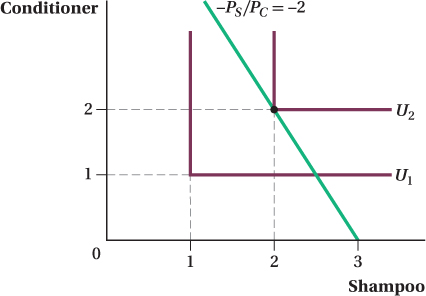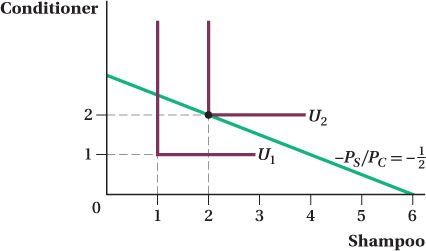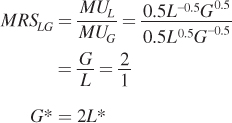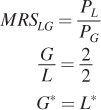Problems
(Solutions to problems marked * appear at the back of this book. Problems adapted to use calculus are available online at www.macmillanhighered.com/
Which assumption about consumer preferences does each of the following individuals violate?
Adam likes basketball more than football; football more than baseball; and baseball more than basketball.
Christina prefers prune juice to orange juice but cannot decide how she feels about grapefruit juice.
Blake likes superhero comic books but prefers 5 comic books to 10 comic books.
By assumption, individual preferences must be transitive so that if A is preferred to B, and B is preferred to C, then A is preferred to C. Suppose that Marsha, Jan, and Cindy individually have transitive preferences over three goods: oranges, apples, and pears. If Marsha, Jan, and Cindy were to vote on whether to name oranges, apples, or pears the “fruit of the month,” show that it is possible the preferences for the group might not be transitive.
Draw two indifference curves for each of the following pairs of goods. Put the quantity of the first good on the horizontal axis and the quantity of the second good on the vertical axis.
Paul likes pencils and pens, but does not care which he writes with.
Rhonda likes carrots and dislikes broccoli.
Emily likes hip-
hop iTunes downloads and doesn’t care about heavy metal downloads. Michael only likes dress shirts and cufflinks in 1 to 2 proportions.
Carlene likes pizza and shoes.
Suppose that John is indifferent between consuming bundle A, which consists of 4 apples and 1 peach, and bundle B, which consists of 4 peaches and 1 apple. If John were given the choice between bundle A and bundle C, which contained 3 peaches and 2 apples, which should he pick? (Hint: Draw an indifference curve or two.)
A and B are two bundles on the same indifference curve U1, so any bundle that lies along the straight line joining A and B will lie on a higher indifference curve. Bundle C, consisting of 3 peaches and 2 apples, is such a bundle so John will choose bundle C over bundle A.

The following table displays the total utility U(X) that corresponds to the number of units of X consumed by three different consumers (Auon, Barbara, and Camira), holding everything else constant:
Auon Barbara Camira U(X) X U(X) X U(X) X 10 2 10 2 10 2 14 3 10 3 12 3 16 4 10 4 15 4 17 5 9 5 19 5 17.5 6 8 6 24 6 Compute the marginal utility of X for each of the three consumers at each level of X.
Based on the data in the table, can you tell whether any of these consumers are violating any of the standard assumptions about preferences?
Is it possible that any of these three consumers have the same preferences, and that columns for the three consumers differ only because of the arbitrary units that are used to measure utility? Explain.
-
A consumer’s utility function is given by U = XY, where MUX = Y and MUY = X.
What is the utility derived from 1 unit of X and 2 units of Y? What is the utility derived from 2 units of X and 1 unit of Y? What is the utility derived from 5 units of X and 2 units of Y?
U(1, 2) = (1)(2) = 2
U(2, 1) = (2)(1) = 2
U(5, 2) = (5)(2) = 10
How does the consumer rank the following bundles?
Bundle Quantity of X Quantity of Y A 2 2 B 10 0 C 1 5 D 3 2 E 2 3 Bundle Quantity of X Quantity of Y Utility A 2 2 4 B 10 0 0 C 1 5 5 D 3 2 6 E 2 3 6 From the table, U(D) = U(E) > U(C) > U(A) > U(B), and we have the ranking (> denotes strictly preferred, ~ denotes indifferent)
D ~ E > C > A > B
Graph an indifference curve that shows the bundles of X and Y for which U= 6 and U= 8. Is the “more is better” assumption satisfied for X and Y?

The “more is better” assumption is satisfied.
144
Kelly’s utility function is given by U= 5X + 2Y, where MUX = 5 and MUY = 2.
What is MRSXY?
What is MRSXY when X = 1 and Y = 5? When X = 2 and Y = 2.5?
Draw a sample indifference curve.
-
Andrea loves to eat burritos with hot sauce. In fact, she cannot enjoy a burrito (B) unless it has three servings of hot sauce (H). She gets no additional enjoyment from more than three servings per burrito. Thus, her utility function is U= min
 . Graph Andrea’s indifference curves for U= 1 and U= 2.
. Graph Andrea’s indifference curves for U= 1 and U= 2. Suppose John’s utility function is 4XY, where X is consumption of beer and Y is consumption of pizza. For this utility function, the marginal utility of X is given by MUX = 4Y; the marginal utility of Y is given by MUY = 4X.
Suppose Y = 3. Calculate John’s utility for X = 2, 3, 10, and 11. For a given level of Y, does good X display diminishing marginal utility?
Suppose X = 3. Calculate John’s utility for Y = 2, 3, 10, and 11. For a given level of X, does good Y display diminishing marginal utility?
Find three different bundles containing X and Y that give John 48 utils of satisfaction. Plot the three bundles and connect them with an indifference curve. What happens to the marginal rate of substitution between X and Y as consumption of X increases?
Does the principle of diminishing MRS depend on the diminishing marginal utility of X and Y?
José gets satisfaction from both music and fireworks. José’s income is $240 per week. Music costs $12 per CD, and fireworks cost $8 per bag.
Graph the budget constraint José faces, with music on the vertical axis and fireworks on the horizontal axis.
If José spends all his income on music, how much music can he afford? Plot a point that illustrates this scenario.
If José spends all his income on fireworks, how many bags of fireworks can he afford? Plot a point that illustrates this scenario.
If José spends half his income on fireworks and half his income on music, how much of each can he afford? Plot a point that illustrates this scenario.
Connect the dots to create José’s budget constraint. What is the slope of the budget constraint?
Divide the price of fireworks by the price of music. Have you seen this number before while working on this problem, and if so, where?
Suppose that a holiday bonus raises José’s income temporarily to $360. Draw José’s new budget constraint.
Indicate the new bundles of music and fireworks that are feasible, given José’s new income.
Suppose that only one person in the world sells ice cream. She employs a strange pricing policy: You can buy 1 ice cream cone for $1, but if you buy 2 cones, you have to pay $2 each. If you buy 3, you have to pay $3 each, etc., so that if you buy 10, you have to pay $10 each. You have $100 dollars to spend on ice cream cones and chocolate milk, and chocolate milk costs $1 per unit. Draw your budget constraint. This strange ice cream pricing, where buying more costs you more, is called a quantity surcharge.
John enjoys ordering out for pizza and renting movies online. He makes $30 each week at a part-
time job. If movies cost $2 per rental and pizza costs $7.50 per slice, graph John’s budget constraint. Then illustrate the effects of each of the following events: John’s mother finds a coupon good for one free pizza and gives it to John.
The company John rents movies from sponsors a holiday week promotion: Rent the first five movies at their regular price, and all movies after the fifth are half off.
John’s favorite pizza place increases the price of pizza from $7.50 to $10.
Good X sells for $4, and good Y sells for $2. At your current level of consumption, the marginal rate of substitution between X and Y is 4.
Draw an indifference curve and budget constraint that reflects the facts given above. (Hint: You will have to choose an initial income level and an initial bundle of X and Y.)
Are you maximizing your utility?
If you are not maximizing your utility, are you buying too much X or too much Y? Explain.
André gets utility from playing laser tag and reading books. Each week, André spends his entire $100 paycheck on both goods. One hour of laser tag costs $20; a book costs $10.
Graph André’s budget constraint. Put books on the horizontal axis and hours of laser tag on the vertical axis.
When André maximizes his utility, he buys 6 books. Carefully add an indifference curve to your graph to reflect André’s utility-
maximizing bundle of books and laser tag. When André maximizes his utility, how many hours of laser tag does he play?
When André maximizes utility, the marginal utility he receives from playing an extra hour of laser tag is 12 utils. How much utility must André get from reading another book?
145
For Maahir, shampoo and conditioner are perfect complements. He likes to use 1 squirt of shampoo and 1 squirt of conditioner each time he washes his hair.
Draw a set of indifference curves for Maahir that illustrate the utility he derives from using shampoo and conditioner.

Assume that shampoo costs $4 and conditioner costs $2. Construct a budget constraint for Maahir and describe his purchasing habits. What is his optimal bundle likely to look like? (Hint: Assume some level of income for Maahir.)
Maahir’s budget constraint is
4S + 2C = 12
Since Maahir likes to consume the two goods, shampoo and conditioner, in a 1 to 1 ratio, he can purchase together 1 unit of each for a total of $2 + $4 = $6. With I = $12 of income, Maahir can afford 2 units of each.

Suppose that prices change so that shampoo costs $2 and conditioner costs $4. What is likely to happen to Maahir's optimal bundle as a result? Explain.
When there is a change in prices so that PS + $2 and PC = $4, the new budget constraint for Maahir will be 2S + 4C = 12. The slope of the budget constraint is now
 but the total cost of a unit of each good (Maahir’s ideal consumption ratio) is still $6, so he can afford to purchase the same bundle (2 units of each good) as before.
but the total cost of a unit of each good (Maahir’s ideal consumption ratio) is still $6, so he can afford to purchase the same bundle (2 units of each good) as before.
How would your answer to (c) change if Maahir used 2 squirts of shampoo and 1 squirt of conditioner each time he washed his hair?
If Maahir likes to use shampoo and conditioner in the ratio 2 to 1, then under the original prices, a bundle consisting of S = 2 and C = 1 would have cost 2(4) + 1(2) = $10. With the change in prices, the same bundle would cost 2(2) + 1(4) = $8. Maahir would now be able to consume the same bundle but would have money left over to consume more of other goods under the new prices.
-
Suppose that there are only two goods, books and coffee. Justine gets utility from both books and coffee, but her indifference curves between them are concave rather than convex to the origin.
Draw a set of indifference curves for Justine.
What do these particular indifference curves tell you about Justine’s marginal rate of substitution between books and coffee?
What will Justine’s utility-
maximizing bundle look like? (Hint: Assume some level of income for Justine and some prices for books and coffee, then draw a budget constraint.) Compare your answer to (b) to real-
world behaviors. Does the comparison shed any light on why economists generally assume convex preferences?
-
Chrissy spends her income on fishing lures (L) and guitar picks (G). Lures are priced at $2, while a package of guitar picks costs $1. Assume that Chrissy has $30 to spend and her utility function can be represented as U(L,G) = L0.5G0.5. For this utility function, MUL = 0.5L–0.5G0.5 and MUG = 0.5L0.5G–0.5.
What is the optimal number of lures and guitar picks for Chrissy to purchase? How much utility does this combination bring her?
Chrissy’s marginal rate of substitution can be determined from her marginal utility for each good. The marginal rate of substitution will be equal to the ratio of relative prices at the optimal consumption bundle:

Chrissy’s optimal bundle must also lie on her budget constraint, 2L + G = 30. Substituting the relation from the tangency condition gives
2L* + 2L* = 30
4L* = 30
L* = 7.5
and
G* = 15
The optimal consumption bundle is (L*, G*) = (7.5, 15), and this will give Chrissy utility U = (7.5)0.5(15)0.5 = 10.6.
If the price of guitar picks doubles to $2, how much income must Chrissy have to maintain the same level of utility?
If there is a doubling in the price of guitar picks to PG = $2, then from the tangency condition:

Chrissy will want to consume the two goods in equal quantities. In order to maintain utility at U = 10.6,
U(L,G) = L0.5G0.5
10.6 = L0.5G0.5
with G* = L* = k
10.6 = k0.5k0.5
10.6 = k
Chrissy will consume the bundle (L*, G*) = (10.6, 10.6), which at the new price for guitar picks will cost
(2)(10.6) + (2)(10.6) = $42.40
Chrissy will require income I′ = $42.40 in order to maintain the same level of utility.
A popular cellular telephone provider offers its customers the following pay-
as- you- go data plan: The first four gigabytes of data cost $10 each; each gigabyte of data after that costs $20. Suppose the typical data customer has $100 to spend on either phone use or chocolate bars, which cost $1 each. Graph the typical customer’s budget constraint.
Add an ordinary-
looking (downward- sloping, convex to the origin) set of indifference curves to the graph, to represent the preferences of the typical customer. How many gigs of data is the typical customer likely to use? Does your answer to (b) depend critically on the steepness or flatness of the typical customer’s indifference curves? Explain.
Suppose that doctors’ visits cost $20, and the typical consumer has an income of $100. Consumers spend all of their incomes on doctors’ visits and a “composite good” (you can think of this as a collection of everything else that consumers want) that costs $1 per unit.
Draw a graph that illustrates the consumer’s budget constraint, putting doctors’ visits on the horizontal axis. Make sure you indicate the horizontal and vertical intercepts.
Now, suppose the local government is considering two health plans. Under plan A, the government will give out vouchers worth 2 free visits to the doctor. Under plan B, the government will give out four 50% off coupons to be used at the doctor’s office.
Draw the new budget constraint the consumer faces under plan A.
Draw the new budget constraint the consumer faces under plan B.
For whom is the choice of plan A or plan B not likely to matter—
those who are quite well, or those who are quite sick? (Hint: Superimpose some indifference curves on your budget constraints.) Which plan would someone who is generally well be likely to choose, if offered a choice?
Cherise considers movies and concerts to be perfect substitutes. When Cherise maximizes her utility, what will the optimal bundle of movies and concerts probably look like? Explain your reasoning by drawing a graph that includes her indifference curves and a hypothetical budget constraint.
146
Economist Joel Waldfogel may be America’s biggest Grinch. He bemoans what he calls the “deadweight loss of Christmas” created when people give gifts (such as ugly sweaters) the recipients would rarely, if ever, buy for themselves.
Draw a graph with a budget constraint showing affordable bundles of a composite good costing $1 and ugly sweaters. (You may assume some level of income and a price for ugly sweaters.)
Cheryl might get some utility from an ugly sweater, but is currently spending all of her income on the composite good. Add an indifference curve that reflects Cheryl’s situation. What must her indifference curves look like?
Suppose Cheryl receives a gift of one ugly sweater from a coworker. Show the effect of the gift on Cheryl’s budget constraint. Where on the constraint is Cheryl likely to maximize her utility?
Waldfogel suggests that the world might be a happier place if instead of giving ugly sweaters, people simply gave an equivalent amount of cash. Draw the budget constraint Cheryl would face were this the case. Add an indifference curve or two to show what happens when Cheryl maximizes her utility. Does the cash gift make her happier than the sweater?
 Work this problem with calculus
Work this problem with calculus